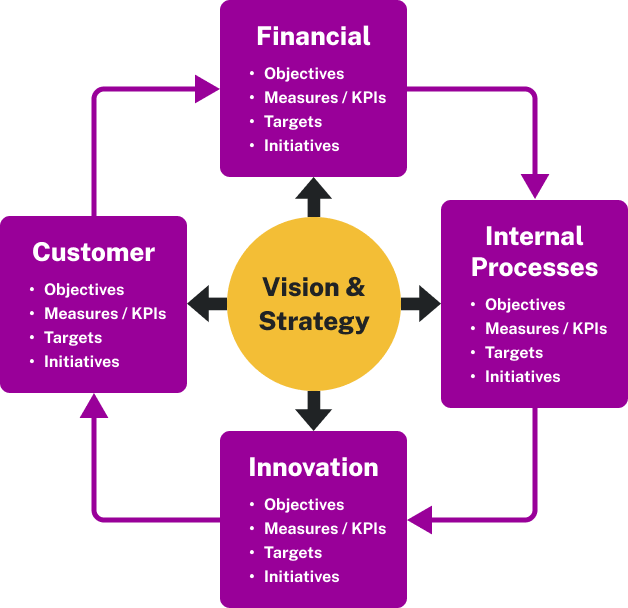Measuring Performance
Performance measurement is the process of collecting, analyzing, and/or reporting information regarding the performance of an individual, group, organization, system, or component. The ways in which managers and organizations measure performance vary greatly—there is no single systemic approach that fits all companies or conditions. The most important element of measuring performance is to do them at regular intervals and/or when particular milestones are reached. The best processes for measuring performance provide information in time for day-to-day decisions.
The rubric for measuring organizational performance is called a performance metric. The American Society for Quality (ASQ) defines performance metrics as “data representative of an organization’s actions, abilities, and overall quality.”[1] Note that the metrics relevant to a business’s performance vary significantly across industries. Because it’s impossible to track all available data regarding an organization’s performance, it’s important to identify the key performance metrics—often referred to as KPIs or key performance indicators—that are most relevant to a specific business’s success. Once defined, the process of measurement and reporting KPI must be clearly documented and communicated so that results are consistent and comparable over time.
Choosing Metrics
In order to be effective, metrics should reflect a range of stakeholder perspectives, including those of customers, shareholders, and employees. Metrics may be finance based or they may focus on some other measure of performance, such as customer service, customer perceptions of product value, or employee satisfaction. Typical financial metrics include revenue or sales growth, gross and net profit, stock price, and market share. Operating metrics generally focus on productivity and quality, including customer satisfaction. For example, Amazon tracks and enforces a number of seller performance metrics including on-time delivery, order defect rate, cancellation rate, and customer service dissatisfaction rate.
The performance metric development process can be summarized as follows:
- Describe the target objective(s)
- Evaluate possible measurements
- Identify the correct metric for each objective
- Set targets and determine how data will be interpreted—for example, setting a range around a target value and defining levels of performance.
- Define and document the performance metric and related processes and procedures.[2]
Analyzing Performance
Once performance has been measured, managers must analyze the results and evaluate whether objectives have been met, efficiencies achieved, or goals obtained. The means by which performance is analyzed vary among organizations; however, one tool that has gained widespread adoption is the balanced scorecard. A balanced scorecard is a semi-standardized strategic management tool used to analyze and improve key performance indicators (KPIs) within an organization. The original design of this balanced scorecard has evolved over the last couple decades and now includes a number of other variables—mostly where performance intersects with corporate strategy. Corporate strategic objectives were added to allow for a more comprehensive strategic planning exercise. Today, this second-generation balanced scorecard is often referred to as a “strategy map,” but the conventional “balanced scorecard” is still used to refer to anything consistent with a pictographic strategic management tool.

The following four perspectives are represented in a balanced scorecard:
- Financial: includes measures focused on the question, “How do we look to shareholders?”
- Customer: includes measures focused on the question, “How do customers perceive us?”
- Internal business processes: includes measures focused on the question, “What must we excel at?”
- Learning and growth: includes measures focused on the question, “How can we continue to improve and create value?”
Managers generally use this tool to identify areas of the organization that need better alignment and control vis-à-vis the broader organizational vision and strategy. The balanced scorecard brings each of an organization’s moving parts into one view in order to improve synergy and continuity between functional areas.
Taking Corrective Action
Once the cause of non-performance or underperformance has been identified, managers can take corrective action. Corrective action is essentially a planned response aimed at fixing a problem. At this stage of the controlling process, problem-solving is key.
Identify the Problem
The first step managers must take is to accurately identify the problem, which can sometimes be hard to distinguish from its symptoms or effects. Collecting information and measuring each process carefully are important prerequisites to pinpointing the problem and taking the proper corrective action. Attempts at corrective action are often unsuccessful because of failures in the problem-solving process, such as not having enough information to isolate the real problem, or the presence of a manager or decision maker who has a stake in the process and doesn’t want to admit that their department made a mistake. Another reason the problem-solving process can run aground is if the manager or decision maker was never properly trained to analyze a problem.
Implement the Solution
Once the problem is identified, and a method of corrective action is determined, it needs to be implemented as quickly as possible. A map of checkpoints and deadlines, assigned to individuals in a clear and concise manner, facilitates prompt implementation. In many ways, this part of the control process is very much a process itself. Its steps can vary greatly depending on the issue being addressed, but in all cases it should be clear how the corrective actions will lead to the desired results.
Assess the Action Taken
Next, it’s important to schedule a review and evaluation of the solution. This way, if the corrective action doesn’t bring the desired results, further action can be taken swiftly—before the organization falls even further behind in meeting its goals. Organizations may also decide to discuss a problem and potential solutions with stakeholders. It’s useful to have some contingency plans in place, as employees, customers, or vendors may have unique perspectives on the problem. Gaining a broader view can sometimes help management arrive at a more effective solution.
- "What Are Performance Metrics?" ASQ. Accessed June 25, 2019. https://asq.org/quality-resources/metrics. ↵
- "How to Develop KPIs / Performance Measures." Kpi.org. Accessed June 25, 2019. https://kpi.org/KPI-Basics/KPI-Development. ↵